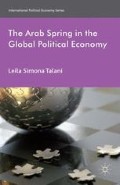Abstract
Starting in December 2010, the Arab world was swept away by a wave of demonstrations that soon became known as ‘The Arab Spring’.1
Access this chapter
Tax calculation will be finalised at checkout
Purchases are for personal use only
Preview
Unable to display preview. Download preview PDF.
References
Alterman, J.B. (2000). Egypt: Stable But for How Long? The Washington Quarterly, Autumn 2000, 107–118.
Bradley, J.R. (2008). Inside Egypt: The Land of the Pharaohs on the Brink of a Revolution. Palgrave.
Bradley, J.R. (2012). After the Arab Spring. Palgrave.
Dicken, P. (1998). Global Shift. Paul Chapman Publishing.
Dicken, P. (2003). Global shift: Reshaping the Global Economic Map in the 21st century. Sage.
Farah, N.R. (2009). Egypt’s Political Economy. American University in Cairo Press.
Gardezi, H. (1995). The Political Economy of International Labor Migration. Black Rose Books, Montreal.
Garret, G. (1998). Partisan Politics in the Global Economy. Cambridge University Press.
Ghosh, B. (1998). Huddled Masses and Uncertain Shores: Insights into Irregular Migration. Martinus Nijhoff Publishers, London.
Ghosh, B. (ed.) (2000). Managing Migration: Time for a New International Regime. Oxford University Press, Oxford.
Hirst, P., and Thompson G. (1999). Globalization in Question. Polity Press.
Holm, H.H., and Sørensen, G. (1995). Whose World Order? Uneven Globalization and the End of the Cold War. Westview Press, Boulder.
Hudson, M.C. (ed.) (1999). Middle East Dilemma: The Politics and Economics of Arab Integration. Columbia University Press, New York.
Kubursi, A. (1999). ‘Prospects for Arab Economic Integration After Oslo’, in Hudson, M.C. (ed.) Middle East Dilemma: The Politics and Economics of Arab Integration. Columbia University Press, New York, ch. 14.
Mittelman, J.H. (2000). The Globalization Syndrome: Transformation and Resistance. Princeton University Press, Princeton.
Overbeek, H. (2000). ‘Globalization, Sovereignty and Transnational Regulation: Reshaping the Governance of International Migration’, in Gosh, B. (ed.) Managing Migration: Time for a New International Regime. Oxford University Press, Oxford.
Owen, R. (1999). ‘Inter-Arab Economic Relations During the 20th century: World Market vs Regional Market?’, in Hudson, M.C. (ed.) Middle East Dilemma: The Politics and Economics of Arab Integration. Columbia University Press, New York, ch. 10.
Pollack, K.M. (2011). The Arab Awakening: America and the Transformation of the Middle East, e-book, http://kcl.eblib.com/patron/FullRecord.aspx?p=795889, accessed 9 May 2013.
Sassen, S. (1996). Losing control. Columbia University Press, New York.
Sassen, S. (1998). Globalization and Its Discontents. The New Press, New York.
Sassen, S. (2006). Territory, Authority, Rights: From Medieval to Global Assemblages. Princeton University Press, Princeton NJ.
Strange, S. (1996). The Retreat of the State. Cambridge University Press, Cambridge.
Talani, L.S. (2004). European Political Economy: Political Science Perspectives. Ashgate, London.
Weiner, M. (1995). The Global Migration Crisis: Challenge to States and Human Rights. HarperCollins College Publishers.
West, J. (2011). Karama! Journeys through the Arab Spring. Heron Books, Kindle edition.
Wickham, C.R. (2002). Mobilizing Islam: Religion, Activism, and Political Change in Egypt. Columbia University Press, New York. Van der Pijl, K. (2011). ‘Arab revolts and nation-state crisis’, New Left Review 70, July–August 2011, pp. 27–49.
Author information
Authors and Affiliations
Copyright information
© 2014 Leila Simona Talani
About this chapter
Cite this chapter
Talani, L.S. (2014). Introduction. In: The Arab Spring in the Global Political Economy. International Political Economy Series. Palgrave Macmillan, London. https://doi.org/10.1057/9781137272195_1
Download citation
DOI: https://doi.org/10.1057/9781137272195_1
Publisher Name: Palgrave Macmillan, London
Print ISBN: 978-1-349-44482-3
Online ISBN: 978-1-137-27219-5
eBook Packages: Palgrave Intern. Relations & Development CollectionPolitical Science and International Studies (R0)

